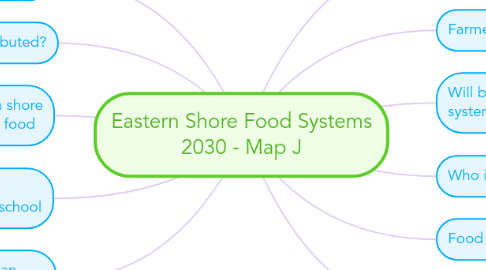
1. 15 Year Strategic Plan
1.1. A 15 year plan could be broken out by 3, 5, 10 and 15 year goals
1.2. Too long!
1.2.1. Agreed - start now
1.2.1.1. To go where? If you don't know where we are going, how do we get there?
1.3. SUMMARY: we don't want to wait 15 years
2. How is food distributed?
2.1. Central or community-based
2.1.1. Transportation issues for consumers
2.1.1.1. Especially with low income
2.2. Logistics and transportation are key, could be centralized for maximum return for producers
2.3. Summary: distribution strategies to access all consumers
3. 50% of people on the Eastern shore are growing 50% of their own food
3.1. Unlikely
3.2. Really?
3.3. Nope!
3.4. Not true?
3.4.1. I agree – that is really wishful thinking. We are lucky if it is 5% of Eastons people growing 50%
4. Local food being used in all restaurants and institutions i.e. school
4.1. How is that going to happen? Schools have required vendors
4.1.1. For now
4.1.2. If parents and community unite, this can change
4.1.3. Required vendors are buying and using local foods
4.1.3.1. Hope so
4.1.3.2. Or stick?
4.1.4. Schools loosen regulations and food hubs and local farmer sell directly to school
4.1.4.1. How is it delivered by whom at what cost?
4.1.4.2. Cost! LG vendors are cheaper
4.1.5. Local producers are vendors
4.1.5.1. How do we create new producers?
4.1.5.1.1. Make sure there's a profit in the work
4.1.5.1.2. Diversify farmers
4.1.5.1.3. There are lots of models nationwide a very successful small farms or pocket farms incubated by smart sustainable eco. dep. programs New Hampshire, Floyd Virginia, etc. Bring more to shore
4.1.6. Have to have a track record of filling orders and meeting vendor expectations – quality product in right amount, on time
4.2. SUMMARY: more buy in by institutions is needed so farmers have a good idea how much and what to plant and have a guaranteed outlet for their products
5. Farming is seen as more of an important and lucrative profession
5.1. Hope so
5.1.1. Ditto
5.2. Lots of young people and middle-aged people farming equals average age of Eastern shore farmer of 42 years old
5.2.1. In New Hampshire and other states the new small sustainable for movement has already brought the average age for farmers down from 72 from a few years ago to mid 30s!
5.2.1.1. Profitable farms needed
5.2.1.2. Quality-of-life
5.2.1.3. We should partner with New Hampshire to have them help us in the right direction. They are number one in the country for having their local food system shored up
5.3. Shift concentrated power of poultry industry so more farmers can compete
5.3.1. Yes!
5.4. SUMMARY: sustainable for movement to shift power from big agriculture
6. There is no system just a lot of small disjointed attempts
6.1. What is the goal of a system approach?
6.1.1. Good question
6.1.1.1. Reduce redundancy, maximize efficiency, share skilled nonfarm specialties like branding, marketing, logistics, transportation, maximize profits and create reliable business model
6.1.1.1.1. Yes!
6.1.2. Seeing all the parts, not just products and dollars
6.2. SUMMARY: Goal of a food system
7. Farmers Market
7.1. Concern: not a sustainable model to have farmers off their farm so much
7.1.1. I agree
7.1.2. Create systems/demand that provides market for local, sustainable food beyond just farmers markets
7.1.2.1. Food hub again
7.2. Quality not quantity
7.3. Enough food variety?
7.4. SUMMARY: farmers markets alone are not enough. Find systems that build more capacity.
8. Will be very similar to current food system
9. Who is the audience/consumer?
9.1. Yuppy Milennials
9.1.1. To Narrow!
9.2. All consumers
9.3. Food insecurity
9.3.1. This is resolved
9.3.1.1. How?
9.3.1.2. Huh? What happens at Perdue leaves? How secure would it be then?
9.3.1.2.1. Great point!
9.3.1.2.2. Poultry will be produced elsewhere, farmers will lose income. Long-term, century, other land based business will come in
9.3.1.2.3. We change paradigms
9.3.1.2.4. Purdue, Mountaire, Tyson, all on the shore
9.3.1.2.5. The transition to chicken and grain took time; so will new transitions. Change does not have to be sudden or catastrophic
9.4. Needs well-done market research to establish clear industry, markets, consumers
9.5. Hospitals, school systems, government
9.5.1. Universities, restaurants, nursing homes, corporate companies, etc.; institutions are buying 50 to 90% of local foods
9.5.1.1. Are you saying this is current 50 to 90% on the goal?
9.6. SUMMARY: purchasers and consumers and related issues
10. Food Hub
10.1. Parameters what foods?
10.1.1. All types of local produce: meats, poultry, eggs, dairy, seafood and value added foods. Locally prepared
10.1.1.1. High-value hair loom
10.1.1.1.1. Are there markets for expensive produce, etc.?
10.1.1.1.2. Whom not the average/lower income person
10.2. Small farmers
10.2.1. Software program to help small farmer set prices and help with aggregation
10.2.1.1. Great identity in the tech industry – create more jobs
10.2.2. Centralize source for farmer access to other business skills – design, social media, logistics, etc.
